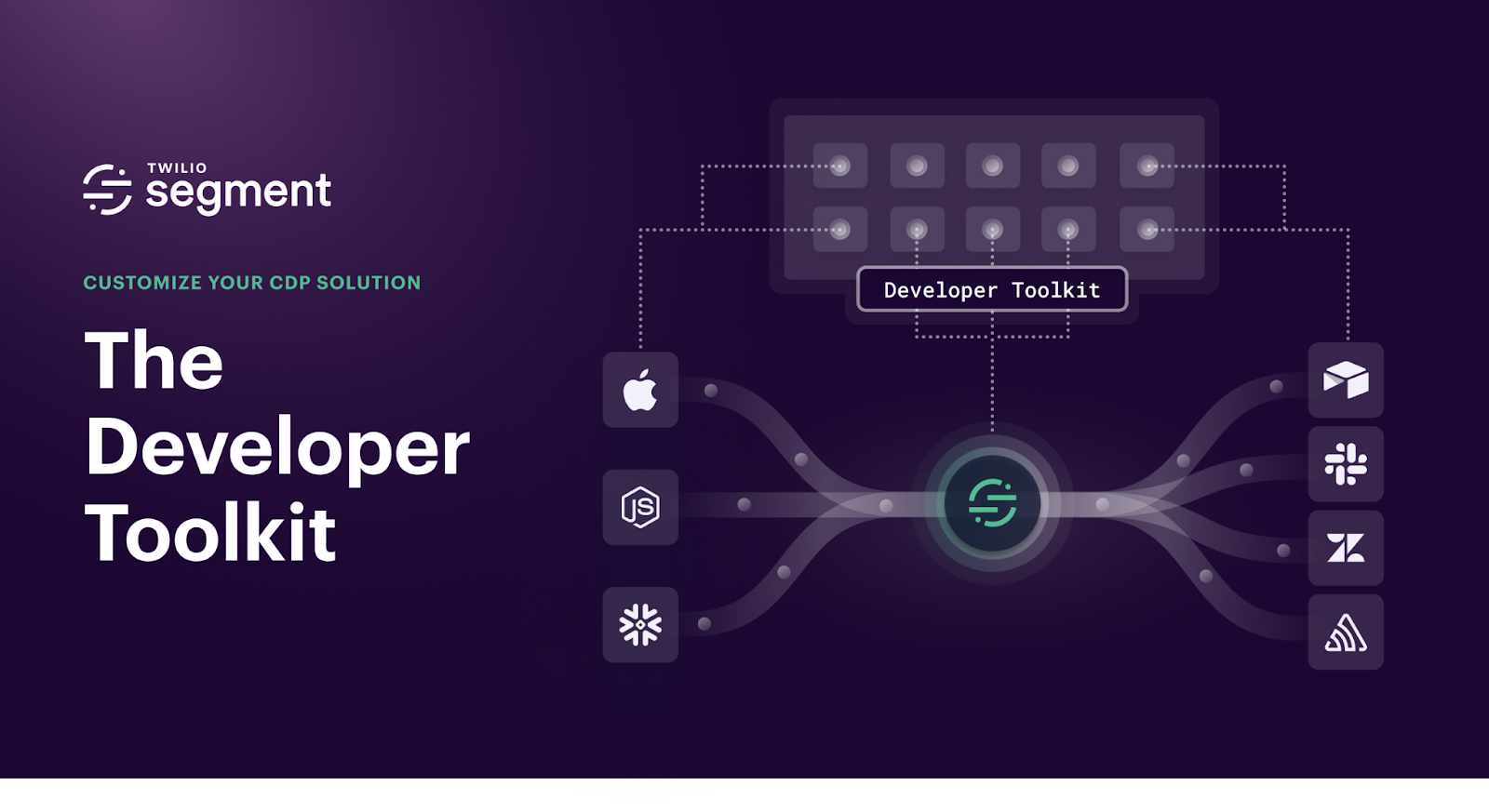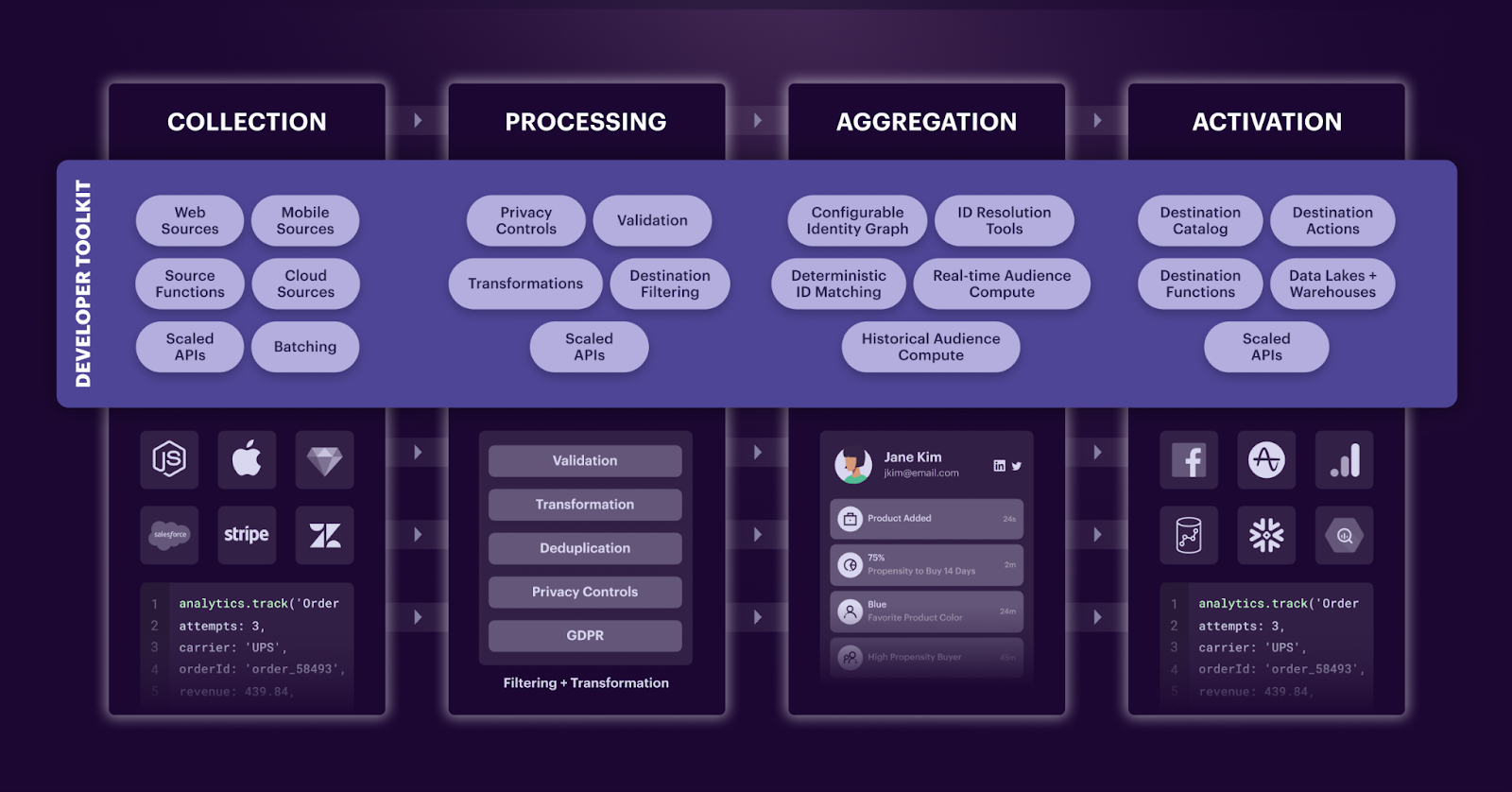Build a Custom-fit CDP Solution Using the Twilio Segment Developer Toolkit
Time to read: 6 minutes

As a developer, you’ve likely tackled the “build vs. buy” question at least once, if not dozens of times, in your career. However, both options don’t have to be mutually exclusive.
The Developer’s Dilemma: Build, Buy, or Both?
We’re in the midst of a fundamental shift in how companies adopt and deploy software.

Let’s trace it back to where it started: the “Build It Yourself” era. In-house IT teams were responsible for solving challenges with technology. They had to build from scratch, which was expensive, slow, and brittle. But it also meant solutions were tailored to the requirements of the business. Every line of code was written to solve a particular problem.
With the rise of cloud computing and SaaS apps, businesses could increasingly buy off-the-shelf tech to solve their problems. However, those tools were inflexible and often didn’t fully meet the needs of the companies that bought them. Plus, in-house developers were on the hook to maintain a growing set of third-party applications, keeping them too busy to focus on other work.
Now, we’re moving to a world in which customers are increasingly buying infrastructure “building blocks.” This provides an ideal middle ground between a high-cost internal build and a low flexibility off-the-shelf solution that doesn’t allow for customization.

You don’t want a solution that dictates how you manage your customer data—that’s up to you! After all, innovation, growth, and outstanding customer experiences come from assembling your infrastructure building blocks in a way that meets your unique business needs.
ClearScore, a leading financial technology business in the UK, is a great example of this done right. By switching from an in-house solution to Twilio Segment, ClearScore was able to drive 3x cost savings while also preserving 25% of engineering resources for innovation instead of ongoing extension and upkeep of their internal system. (You can read the full ClearScore case study here.)

Today’s most innovative companies don’t buy all-in-one SaaS suites; they invest in building blocks that empower developers to build the systems that drive personalization and growth.
Introducing the Twilio Segment Developer Toolkit: Your CDP Building Blocks
Customer engagement has been THE buzz word in the martech industry for years. It’s a catchall statement for the experiences customers have on websites and apps, the emails they receive, the ads they interact with, and so on.
All companies want engaged users. And customer engagement skyrockets when you deliver more personalized and relevant experiences. This has led to an explosion of martech tools, which in turn has added complexity to every company’s data infrastructure, requiring dedicated developer support. Developers are forced to spend hours managing martech integrations, and less time on more meaningful work. According to Forrester, 45% of martech users acknowledge that their current environments are too complex.
So how do you navigate this complexity? At Segment, we’ve known from the start that the key requirement to solving engagement challenges is to solve the core data problem.
With the Developer Toolkit, companies are empowered with the building blocks they need to connect and route their trusted, secure, first-party data wherever their teams need it. It provides your developers with the tools they need to customize and extend the Twilio Segment platform. Your developers can support custom configurations to:
- Streamline data collection. Save time setting up your analytics infrastructure and improve the performance of your apps or websites by using the most performant data sources. Access the latest libraries, SDKs, and server-side sources to simplify data collection across every app, website, or cloud SaaS platform that your company uses. (This includes Twilio and Twilio SendGrid-specific cloud sources.)
- Customize and extend your integrations. Access pre-built integrations or blaze a new path and build your own. Either way, you have the ability to customize and control how you integrate data across the tools and platform your team requires.
- Scale your data infrastructure effortlessly. Future-proof your data infrastructure by working with a flexible and extensible solution that can easily scale as your company grows and introduces new requirements.

New additions to the Developer Toolkit
Twilio Segment has always provided tooling to make developers' lives easier. Since our founding decision to open source our analytics.js library, we've evolved into a robust platform to centralize and manage customer data for all teams.
Most recently, we’ve shipped a number of new features to make data collection and integration even more flexible and scalable. The Developer Toolkit includes:
- Analytics.js 2.0: a powerful and simple way to track customer data for your website without having to learn, test, or implement a new API every time. Analytics.js 2.0 has been re-engineered from the ground up to improve performance, data observability, and the overall developer experience.
- Batching for Analytics.js 2.0: With the updated Analytics.js 2.0 library, you can now send events in a batched fashion. Batching events improves app performance by significantly reducing the number of requests, requires fewer API calls by delivering multiple events per call, and creates less noise when errors occur with batched retries.
- Swift and Kotlin libraries: Analytics Swift and Analytics Kotlin libraries provide a simple, modern instrumentation experience for mobile apps. Both offer significant improvements to performance, data observability, and the overall developer experience. These new libraries are currently in pilot.
- Destination Actions: With Destination Actions, you have more control over how data is mapped to a specific destination. You can orchestrate custom actions and tailor predefined actions within the Twilio Segment UI to trigger specific behavior in destinations, such adding a user to an audience, creating or updating a user profile, or initiating a broadcast campaign. This is currently in public beta.
- Multi-Instance Destinations: Multi-Instance Destinations gives you the ability to move faster by customizing destinations to support multiple teams and use cases. It unlocks the ability to route the same data to multiple instances of a destination. This is especially useful if you need to support multiple teams or need to migrate from one instance of a destination to another without losing any data.
These newly added features add to the extensive list of features already available to developers that span the entire Twilio Segment platform, including:
- Data Collection: Implementing data collection across websites, mobile apps, and internal tools is a core component of any CDP. Segment has 40+ pre-built libraries across web, mobile, cloud, and server to collect data from any source, so that you don’t have to slow down and fiddle around with REST APIs. In addition, toolkit features like the Debugger and Event Delivery deliver best-in-class data observability, while Source Functions allow you to bring in data from any upstream tool or service that supports outbound webhooks.
- Data Processing: Data can be messy. As anyone who has dealt with third-party APIs, JSON blobs, and semi-structured text knows, most of their time is spent sanitizing the data, rather than uncovering insights and moving on data-driven decisions. With Twilio Segment, you have access to tools that make sure your data infrastructure can handle GDPR suppressions across millions of users, transform and format individual events, and automatically deduplicate retried requests to make sure your data stays clean and accurate.
- Data Aggregation: Individual events don’t tell the full story of a user. For that, you need to combine all that data into a single profile. This is where most systems hit their scaling limits. Not only do they need to process tens of thousands of events per second, but they need to route that data to a single partition. Segment takes care of the heavy lifting — such as lookups in milliseconds, thousands of queries per second, real-time and historical user computations, and more — that can take teams many months, and even years, to try to set up themselves. Plus, features like our Configurable Identity Graph and Profile API put you in control of creating and utilizing your customer profiles.
- Data Activation: Once you finally have data in one spot, there’s one last step—using that data. That means getting it into all of the different consumers and end tools. Twilio Segment has a range of features that put you in control of how your data is delivered to end tools, including 400+ pre-built destinations, warehouses, and data lakes, as well as Destination Functions, which enable you to build your own destinations entirely.
The Developer Toolkit in action
SmarttBot, a technology company that automates stock exchange investing for individual traders, tapped into the Developer Toolkit to quickly build new revenue driving programs. Using Functions, the SmarttBot team quickly built custom workflows, product features, and advanced marketing campaigns on top of its app. Doing so enabled them to maximize developer productivity while unlocking new revenue streams. (Check out the full case study here.)

Getting started with Twilio Segment
While applications and packaged software promise time savings, it often comes with a high price tag and unforeseen development requirements that take hours away from a developer’s core work. The limitations of most solutions require tedious workarounds in order to meet each company’s unique business and data needs.
The Developer Toolkit gives developers the tools they need to extend the Twilio Segment platform and support the custom configurations required to streamline data collection, customize integrations as needed, and scale their data infrastructure effortlessly.
The Developer Toolkit is available to all Twilio Segment customers. You can learn more about what’s included in the Developer Toolkit for Twilio Segment customers (as well as Open Source tools that are available to any developer) here.
To get started building your custom data infrastructure today, you can sign up for a free account here (built specifically for Twilio Developers looking to get started with Segment) or request a personalized demo.
Related Posts
Related Resources
Twilio Docs
From APIs to SDKs to sample apps
API reference documentation, SDKs, helper libraries, quickstarts, and tutorials for your language and platform.
Resource Center
The latest ebooks, industry reports, and webinars
Learn from customer engagement experts to improve your own communication.
Ahoy
Twilio's developer community hub
Best practices, code samples, and inspiration to build communications and digital engagement experiences.